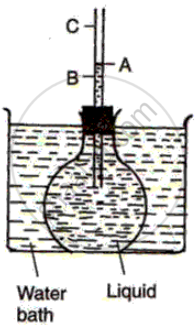Advertisements
Advertisements
प्रश्न
उत्तर
Fill a round bottom flask with a coloured liquid up to the brim. Fit it with a one holed cork and pass a narrow glass tube through it. Mark the level of the liquid in the glass tube as A. Place the flask in a water bath and heat the bath. You will see that the level of liquid of water starts falling to level Band then it rises to level C. In this, AC is the apparent expansion and is due to expansion of the flask due to heating which provides more space for the liquid. Hence the level of liquid drops. As soon as the liquid also starts getting heated up, it expands and the level of liquid rises. BC is the real expansion. So the actual expansion of the water is the sum of AC and AB.

APPEARS IN
संबंधित प्रश्न
The increase in length of a metal rod depends on
Two identical rods of copper are heated to different temperatures — one by 5°C and the other by 10°C. Which rod will expand more?
Iron rims are heated before they are fixed on the wooden wheels.
An empty glass bottle is fitted with a narrow tube at its mouth. The open end of the tube is kept in a beaker containing water. When the bottle is heated, bubbles of air are seen escaping into water. Explain the reason.
Describe an experiment to show that same volume of different liquids heated to same rise in temperature expand by different amounts.
At what temperature the pure water has (a) maximum density (b) minimum volume?
What is the velocity of thermal radiations?
Give reason for the following
An ordinary glass bottle cracks when boiling water is poured into it, but a borosilicate glass bottle does not.
Analogy:
Ordinary glass:: Glass tumbler.
Pyrex glass:: ______.
